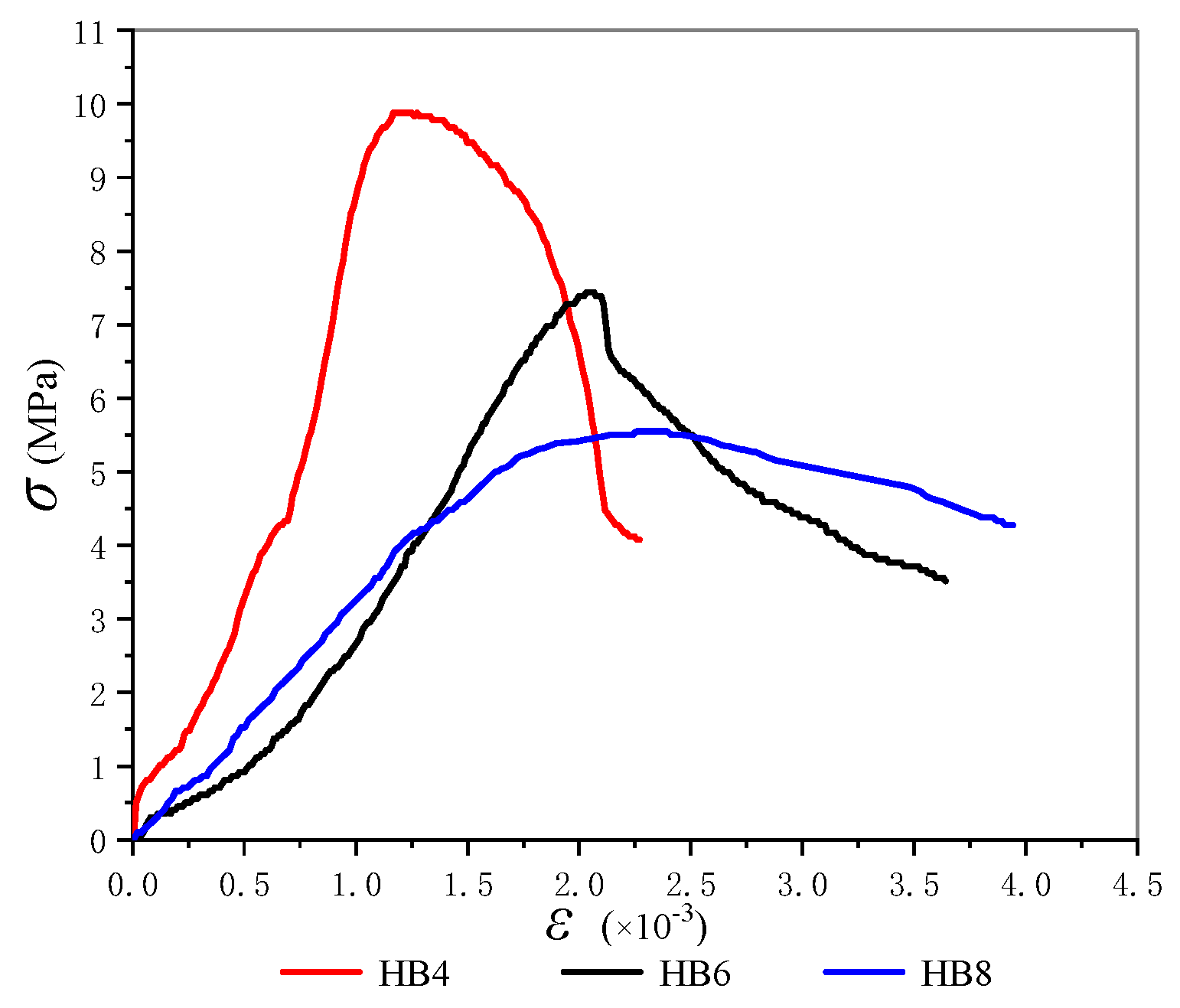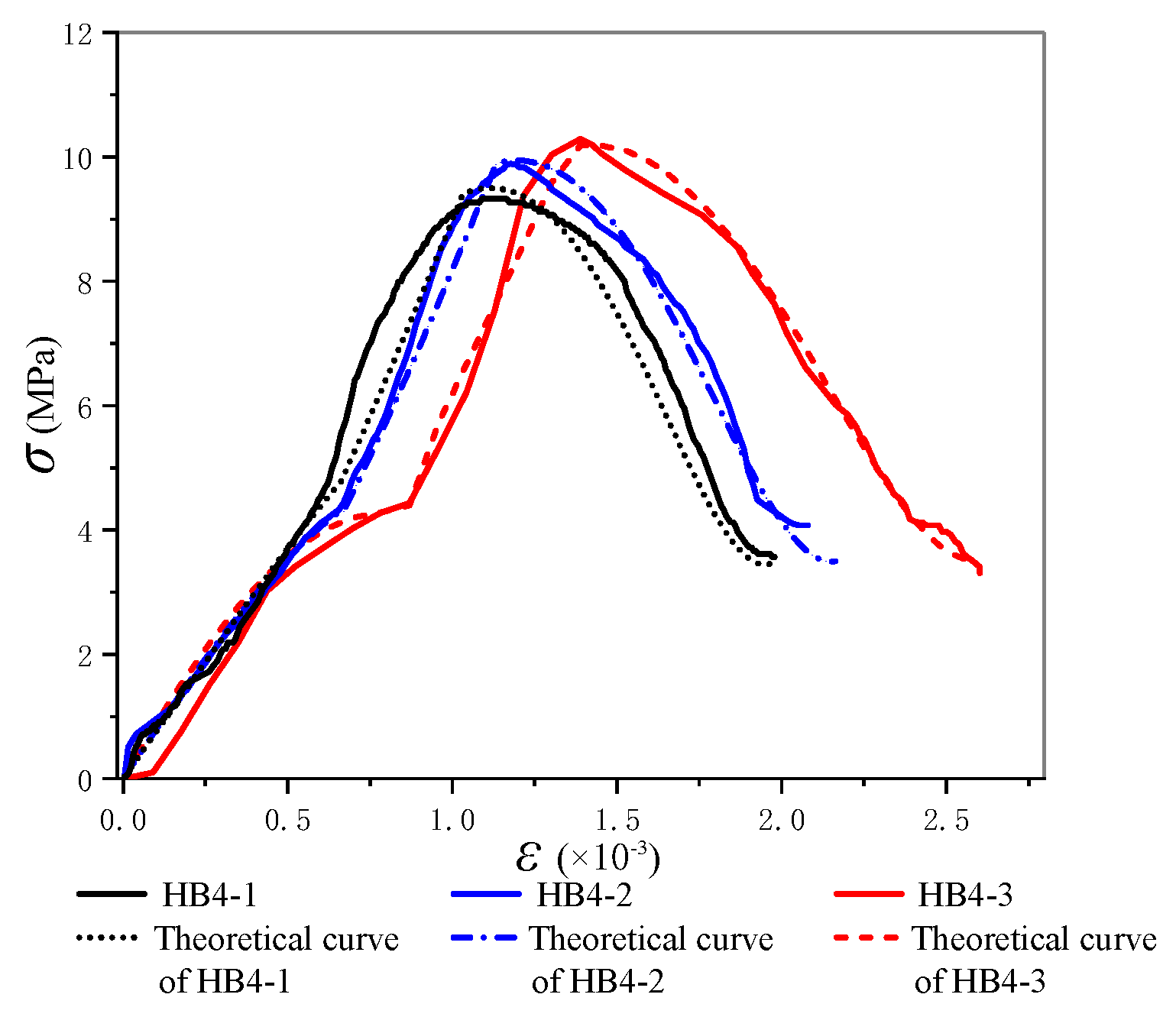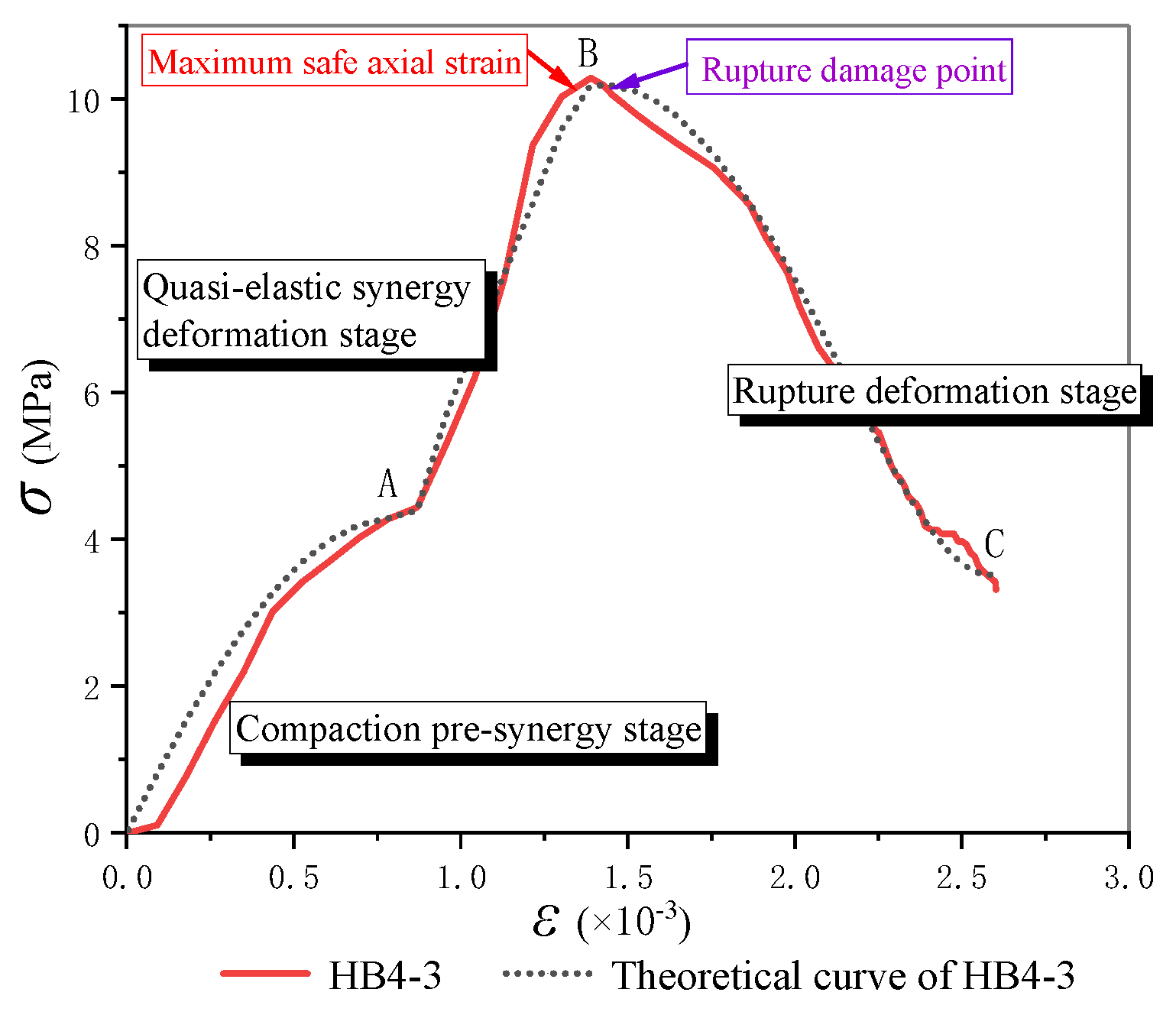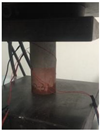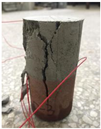1. Introduction
Deep mining is one of the major technical issues faced by the mining industry. With the increase of mining depth, the ground pressure and roadway offset increase resulting in frequent occurrence of rock burst, which significantly increases the difficulties in maintaining the stability of roadway and stope. The filling mining method is more and more widely used for its high resource recovery rate, which also effectively prevents roof caving and stope collapse, as well as meets the requirements of green mine construction. In the process of underground filling, the surrounding rock and filling form a kind of heterogeneous, discontinuous and nonlinear special support. The surrounding rock and filling work together to bear the load of overburden, which has complex mechanical properties and deformation and failure mechanisms [
1,
2,
3]. Therefore, it is necessary to establish the common bearing mechanical model of backfill-surrounding rock combination (BSRC) and study the damage evolution characteristics of surrounding rock and backfill after reasonable matching, which has an important reference value for exploring the damage and failure mechanism of the BSRC model in deep mining.
In order to improve the safety of underground filling mining areas, a lot of research on the mechanical properties, loss and failure characteristics of rock and backfill have been carried out world widely [
4,
5,
6,
7]. In terms of rock damage and failure, many scholars have analyzed the damage evolution in the process of rock deformation, and failure through experimental means and established constitutive models [
8,
9,
10,
11]. Bustamante et al. [
12] proposed a nonlinear constitutive relation to simulate the properties of sandstone and studied the compressional and shear wave properties of rock under compression, finding that the compressional wave velocity is related to the compressive load. Zhao et al. [
13] discussed the fracture toughness and subcritical crack propagation of rock under different environments, established a simple and practical rheological fracture model of rock crack and proposed a modified shear strength model of filled joint. Shahin et al. [
14], based on viscoelastic and nonlinear dynamics, gave a mechanical interpretation of compaction creep and defined a constitutive operator to describe the evolution of compaction creep, so as to evaluate the spontaneous accumulation of pore collapse in the active compaction zone. In addition, by comprehensively considering the effects of damage threshold and residual strength, the Drucker Prager criterion, Harris function, Nishihara shear creep model and Burgers shear creep model of rock micro unit strength were improved; the deformation characteristics and long-term shear strength of rock during creep were analyzed, and the statistical constitutive models of rock damage and strain softening were established, respectively [
15,
16,
17,
18,
19]. In terms of backfill, many scholars have conducted a lot of research on the properties and failure modes of filling materials [
20,
21]. Shahsavari et al. [
22] considered the different behaviors and irreversible thermodynamics of concrete in tension and compression, decomposed the Gibbs potential energy of concrete into three parts, elasticity, damage and healing, and obtained the evolution equation of damage and healing variables by using Clausius Duhem inequality. In addition, lots of laboratory tests on filling materials with different lime sand ratio have been conducted. Based on the experimental results and damage mechanics theory and combined with the research results of fracture characteristics of different filling materials, the defect coupling constitutive models based on continuous damage mechanics were established [
23,
24,
25]. With the wide application of filling mining method, the existing research on the deformation and failure of filling material and backfill under load is also more in-depth.
The above studies only focus on the damage evolution process of rock or backfill under different conditions. Considering that in the process of underground filling, the backfill is greatly affected by confining pressure from the surrounding rock. Koupouli et al. [
26] showed that the interface of backfill with low cement content showed strain hardening behavior, and the shear strength between backfill and surrounding rock was affected by cohesion and internal friction angle. Fang et al. [
27] experimentally studied the influence of different curing temperatures on the shear behavior and strength of the CPB-rock interface and found that higher curing temperature could improve cement hydration and self-drying rate, thus increasing the peak shear stress at the interface between CPB and rock in the early stage. Falaknaz et al. [
28] used the numerical simulation method to create the response of two adjacent filling stopes. Based on the explicit relationship between Poisson’s ratio and the friction angle in the backfill, the stress state of the filling stope was changed. The simulation results expressed in stress, displacement and strain explained the influence of different parameters and evaluated the interaction between the filling material and surrounding rock to ensure the safe application of the filling material. The above research on the combined action of surrounding rock and backfill mainly involved their mechanical action mechanism and only studied the failure law, without considering the synergistic effect, and thus the damage constitutive model was established [
29,
30,
31,
32]. The surrounding rock and backfill were regarded as independent individuals and studied their roles under different combination structure modes, respectively. However, under the action of load, the surrounding rock and backfill form a composite by compression contact coupling. The properties and strength of the two materials are different, and the deformation and failure mode and law will inevitably change.
In this study, the backfill-red sandstone combination is prepared by red sandstone and full tailings cemented backfill with different cement–sand ratios. The uniaxial compression tests are carried out, and the deformation and failure characteristics of the composites in the uniaxial compression process are analyzed. The appropriate cement–sand ratio to realize the synergy between red sandstone and backfill is obtained. According to the stress–strain curve of the specimens during the compressing process, the damage constitutive relationship of the backfill-red sandstone combination under uniaxial compression is analyzed. Combined with the damage constitutive and elastic–plastic theory, the damage process is divided into three stages including compaction pre-synergy stage, quasi-elastic synergy deformation stage and rupture deformation stage. The damage constitutive model of the backfill-red sandstone combination is established which is able to describe the damage evolution law of the synergistic action between the surrounding rock and backfill. The obtained results provide an important reference value for improving the damage theory and failure mechanism of interaction between surrounding rock and backfill.
4. Synergy Support Damage Constitutive Model
According to the stress–strain curves as well as failure characteristics of the specimens, it is found that at the cement–sand ratio of 1:6, the upper backfill is completely destroyed, while the lower red sandstone corner is slightly damaged. The backfill and red sandstone cannot achieve the role of synergy support. When the cement–sand ratio is 1:8, the stress–strain curve of the upper backfill part basically coincides with the composite specimen. The main damage of the composite is the backfill while the lower red sandstone is almost not damaged. The overall compressive strength and elastic modulus are small, and the backfill and red sandstone fail to achieve synergy support. Only when the cement–sand ratio is 1:4, the cracks occur in both the backfill and red sandstone. The composite specimens composed of red sandstone and backfill realize the synergy support and common bearing.
For the backfill-red sandstone combinations with the cement–sand ratio of 1:4, the loading damage can be equivalent to the coupling of two damage states of backfill and red sandstone. The first part is the damage state of the initial backfill, that is, the initial damage caused by the initial defect on the upper part of the delamination plane. The second part is the common damage state of the backfill and the loading of red sandstone part, that is, the damage caused by the continuous loading of the backfill-red sandstone combination. The third part is that the backfill and red sandstone bear together until damage and rupture expansion occur. Layered structure and load weaken the cohesion of materials with different mechanical mechanisms. Combined with the damage and failure characteristics of backfill-red sandstone combination specimens, the uniaxial compression failure process can be divided into three stages: compaction pre-synergy stage (OA), quasi-elastic synergy deformation stage (AB) and rupture deformation stage (BC) (
Figure 9).
4.1. Constitutive Model in Compaction Pre-Synergy Stage (OA)
From a macroscopic point of view, the backfill-red sandstone combinations did not rupture at the beginning of the loading process. However, it can be found that due to the mutual bonding between the upper backfill and red sandstone, the microcracks at the contact surface between the backfill and the rock compacted rapidly. With the increase of strain, the stress obviously shows a non-linear elastic rise. At this time, the microcracks in the upper backfill are slowly compacted with the increase of load, and the micro elements in the internal structure of the backfill are damaged. With the continuous increase of stress, the composite specimen enters the non-linear elastic failure stage, and the stress–strain curve shows the OA segment, which is called the compaction pre-synergy stage. According to experimental data and stress–strain curve, it is identified that there is a certain relationship among the elastic modulus of the backfills, red sandstone and the combinations. In practical engineering, the elastic modulus of the backfill after curing and consolidation is lower than red sandstone. At this time, the main function of the backfill is to transfer load. Therefore, the concept of relative contribution degree is introduced to preprocess the initial weight of elastic modulus of red sandstone and backfill, that is, the contribution degree
η is set. According to the bearing capacity characteristics of red sandstone and backfill during loading, the response model of their elastic modulus during initial loading is obtained:
where
E0 is the initial elastic modulus of the combination;
η1 is the relative contribution of backfill;
η2 is the relative contribution of red sandstone;
Ec is the elastic modulus of the backfill;
Eh is the elastic modulus of red sandstone.
Under load, the deformation mechanism of the internal meso element of the combination specimen is complex. The damage theory is introduced to characterize the change law of the meso element. At this stage, the meso element strength of backfill-red sandstone combination specimen tends to follow Loland damage model [
34]. Under the action of continuous load, the relationship between stress and strain of the OA segment can be obtained:
where
is the effective stress;
ε is strain;
D0 is the initial damage, and the specimen has certain damage before loading. Because the current technical conditions cannot well measure the damage in the initial stage, it is considered that
D0 = 0.
Therefore, the damage constitutive model of the OA segment can be obtained as follows:
where
De is the damage variable of the OA segment.
According to the stress–strain curve of the OA segment, the microcracks in the backfill are closed under the action of load, resulting in micro element structure damage. The damage value
De is expressed as:
where
C and
β are the backfill material parameters.
Based on the stress–strain curve and the boundary conditions:
4.2. Constitutive Model in Quasi-Elastic Synergy Deformation Stage (AB)
Under the action of continuous load, the backfill-red sandstone combination has no macro rupture. At the micro level, the internal deformation and failure of the upper backfill occurred slowly. The internal structure of the lower red sandstone is also damaged, resulting in micro element damage. The backfill-red sandstone combination is like linear elastic deformation, and its internal original damage begins to intensify and evolve until it exceeds the peak stress failure. The stress–strain curve shows the AB segment, which is called the quasi-elastic synergy deformation stage of backfill and red sandstone. Considering the contribution of backfill and red sandstone to the composite, the response model of elastic modulus at this stage is obtained:
where
Ep is the peak elastic modulus of composite;
is the relative contribution of backfill in the AB segment;
is the relative contribution of red sandstone in the AB segment.
According to the stress–strain curve of the AB segment, the damage constitutive model of stress and strain can be obtained:
where
ε is the strain of the composite specimen in section AB;
Dp is the damage variable of the AB segment.
At this stage, the micro element strength of backfill-red sandstone combination specimen obeys Weibull distribution [
35,
36], the probability density function is
where
F is the stress level of the composite specimen in the AB segment;
F0 is the characteristic stress;
b is the distribution parameter.
where
is the strain parameter of the AB segment.
Thus, substituting Equations (11) and (12) into Equation (10) can obtain:
By integrating Equation (13), the damage variable expression can be obtained as follows:
Substituting Equation (14) into Equation (9) can be obtained:
In the stress–strain relationship curve of the composite, the peak stress
σp and the corresponding strain
εp also meet the boundary conditions of Equation (5). Thus:
The partial differential equation obtained from Equation (15) is
Substitute Equation (17) into Equation (5) to obtain:
According to Formulas (16) and (18), it can be obtained:
4.3. Constitutive Model in Rupture Deformation Stage (BC)
After reaching the peak value, both the upper backfill and the lower red sandstone are damaged, and the backfill appears complex damage phenomena such as cracks propagation, bifurcation and detour. The cracks of the red sandstone develop rapidly and show splitting cracks in varying degrees. At this time, the stress of the composite specimen gradually weakens, and its bearing capacity decreases rapidly with the increase of axial strain. The stress–strain curve shows the BC segment, which is called the rupture deformation stage of backfill-red sandstone combination specimen. At this stage, according to D. Krajcinovic [
37], it is assumed that the damage and strain principal axis coincide with the material principal axis in the process of the uniaxial compression. Assume the equivalent stress is
, and the equivalent strain is
, the equation
can be obtained. Thus, the constitutive equation is
According to the stress–strain curve of the BC segment, the constitutive relationship of the backfill at this time is as follows:
where
σ is the stress of the BC segment;
ε is the strain of the BC segment;
Dr is the damage variable of the BC segment.
Considering the residual strength of composite specimens and the damage characteristics of actual stress–strain curves, the above constitutive equation was improved:
where
σr is residual strength of the backfill-red sandstone combination.
For the whole process of the BC segment, severe damage will occur in the backfill-red sandstone combination after reaching the stress peak. The damage variable can be expressed as
where
A and
N are the material parameters of the composite.
Considering the boundary conditions, the following is obtained from Equation (5):
5. Model Validation
5.1. Relative Contribution Value
For determining the relative contribution value, the mechanical interaction model between backfill and red sandstone is analyzed. In order to simplify its mechanical model, lateral constraints and lateral deformation of backfill are temporarily ignored in the laboratory test, and the model shown in
Figure 10 is obtained.
Ec and
εc are the elastic modulus and strain of backfill,
Eh and
εh are the elastic modulus and strain of red sandstone, respectively.
Eh is significantly higher than
Ec.
According to the failure characteristics of the specimens, the load in the initial stage mainly acts on the microcracks compaction process of the backfill and the surface contact between the backfill and red sandstone. Based on the characteristics of stress–strain curve and engineering experience, the relative contribution of the elastic modulus of red sandstone at this stage to the elastic modulus of the initial composite can be calculated and distributed as follows:
At this time, the relative contribution of the elastic modulus of the backfill to the elastic modulus of the initial composite is
In the next stage, with the continuous loading, the upper backfill and the lower red sandstone bear the load together. At this time, the relative contribution of the elastic modulus of the red sandstone to the elastic modulus of the composite is
At this time, the relative contribution of the elastic modulus of the backfill to the elastic modulus of the composite is
In the initial stage, the microcracks in the upper backfill and the microcracks in the stratified contact surface are compacted under the action of load. This process is the full combination process of the upper backfill and the lower red sandstone, so as to achieve the purpose of synergy. The lower red sandstone bears the load and the gravity of the upper backfill, so its relative contribution is high. In the next stage, with the continuous increase of load, the upper backfill and the lower red sandstone are fully combined to achieve the synergistic support effect. In this stage, the relative contribution of the upper backfill and the lower red sandstone is basically the same. The calculation results of relative contribution are shown in
Table 4.
5.2. Verification of Damage Parameters and Constitutive Equations
In order to verify the deduced constitutive model, three backfill-red sandstone combination specimens with the cement–sand ratio of 1:4 are compared and analyzed. The mechanical parameters of three backfill-red sandstone combination specimens are shown in
Table 5.
Based on the data in
Table 5, the stress value of intersections of the three-stages are calculated (
Table 6). The error between theoretical calculation and experiment value is slight. The theoretical curves of the constitutive model are constructed and compared with the test curves. As shown in
Figure 11, the theoretical curves of the model are consistent with the test curves, which confirmed the validities of the proposed constitutive model to described characteristics of the whole damage deformation stage of the specimens.
It can be found that the experimental curves basically have three stages: compaction pre-synergy stage, quasi-elastic synergy deformation stage and rupture deformation stage (
Figure 12). The three types of damage constitutive relations established according to these stages are in good agreement with the experimental curves. However, due to the influence of experimental environment, experimental errors and other factors, there are still some differences in each group of data. According to the damage deformation characteristics and test results in each stage, the damage constitutive equation and damage deformation characteristic diagram of each stage are obtained (
Table 7).
5.3. Damage Variable and Evolution Law
According to its load damage, the synergy deformation of the specimens can also be divided into three stages. The first stage is the microcracks compaction process of the upper backfill and layered contact surface. The second stage is the common bearing process of the upper backfill and the lower red sandstone. The third stage is the rupture process of backfill-red sandstone combination. The damage patterns in each stage are different. According to the established damage constitutive model, the damage evolution process of backfill-red sandstone combination can be characterized, and the relationship between damage variables and strain can be obtained, as shown in
Figure 13.
According to
Figure 13, it can be found that in the process of the uniaxial compression, the initial damage in the upper backfill is less than 0.1 due to the influence of microcracks. With the continuous increase of stress, the lower red sandstone and the upper backfill bear the load together. The damage increases sharply, and cracks appear after exceeding the peak stress. With the continuous action of load, the damage of backfill-red sandstone combination continued, and the specimen was completely destroyed. The macro failure patterns, micro damage variables, overall deformation and failure characteristics all prove that the backfill-red sandstone combination realize the synergistic support at the cement–sand ratio of 1:4. This provides a reference for the study of synergistic support between backfill and surrounding rock in the process of underground filling. The results also provide a basis for the damage evolution law and failure process of the synergy support between backfill and surrounding rock.
5.4. Synergy Analysis between Backfill and Red Sandstone
In the process of actual backfill mining, the backfill and surrounding rock form a combination to bear ground pressure together. This leads to an interaction system between rock mass and backfill. From the compression tests, it was found that the interaction and matching effect between the backfill and red sandstone were affected by the cement–sand ratio. The larger the cement–sand ratio, the higher the strength of the backfill and the greater load-carrying capacity of backfill-red sandstone composite. When the cement–sand ratio was 1:4, the part of backfill had the highest strength, which can fully cooperate with red sandstone to resist the load. The peak stress reached 10.29 MPa. The cracks occurred in both the backfill and red sandstone and propagated to form split failure. When the cement–sand ratio was 1:8, the backfill failed to cooperate with red sandstone. Only the backfill part of composite broke completely. Therefore, the strength of backfill is the key to realize the synergistic support for backfill mining. In the actual mining engineering, in order to save the cost, mining industry is looking always to lower cement ratio in their mixtures. To solve this problem, the new cementing material with low cost can be selected in the future to obtain the backfill with low ratio and high strength.
In this research, the backfill with cement–sand ratio 1:4 had a good matching effect with the red sandstone. During the load-carrying process, the backfill and red sandstone complemented each other and each played their own role. The two achieved synergistic support. According to stress–strain curves and failure characteristics, their functions were analyzed. The relative contribution degrees of backfill and red sandstone were proposed and calculated. The damage constitutive models were established. From the viewpoint of damage, the synergistic mechanism between the backfill and red sandstone was analyzed. In the initial stage, the backfill and red sandstone bore the load together. The interaction of two parts produced the resistance force inside them, and the internal structure was damaged. At this stage, the damage changed slowly, and it provided the foundation for the matching of the two. In the second stage, the strength of backfill matched with the red sandstone, and the first inflection point of the damage variable curve appeared. Under the stress at this point, the backfill should be broken, but in fact, there were no macroscopic cracks in it. For damage variable, the change rate accelerated with the increase of load from this point on. At the end of this stage, the second inflection point of variable damage appeared, and there was peak stress at this point. Then, in the third stage, the synergistic effect between backfill and red sandstone continued. With the continuous increase of load, the rate of damage change decreased compared with that in the previous stage. The through crack was rapidly generated and expanded, and the composite was finally damaged. The damage process reflected the synergistic support between the backfill and red sandstone; the bearing and support effect of composite was no longer dependent on one of them because their support depended on both.
6. Conclusions
Uniaxial compression tests on the backfill-red sandstone combination with different cement–sand ratios were carried out. It was found that at the cement–sand ratio of 1:4, backfill and red sandstone realized synergistic support; the two parts interacted and restricted each other, jointly resisted external loads and played a role in common bearing. However, with the decrease of the cement–sand ratio, the stress mainly acted on the filling materials, and the deformation observed in the backfill was large while there was no obvious rupture in the red sandstone. The backfill-red sandstone combination with the cement–sand ratio of 1:4 had a splitting failure and obvious ruptures. With the cement–sand ratio of 1:6, the upper backfill of combination specimen had a V-shaped rupture, and the lower red sandstone had some small cracks. With the cement–sand ratio of 1:8, the upper backfill of the backfill-red sandstone combination had a “slope” rupture, and there were no cracks in the lower red sandstone.
According to the stress–strain curve of the specimens, the damage failure process is divided into three stages: compaction pre-synergy stage, quasi-elastic synergy deformation stage and rupture deformation stage. The damage constitutive models in each stage are established, respectively. The damage of backfill-red sandstone combination under load is equivalent to the coupling of two damage states of backfill and red sandstone. The theoretical curves obtained from the damage constitutive model are highly consistent with the experimental curves which confirmed the validities of the proposed constitutive model to describe the coupling relationship between the red sandstone and the backfill. The results obtained from this study are of great significance for accurately understanding the synergy relationship between backfill and surrounding rock and for selecting reasonable backfill strength and material ratio in goaf.







